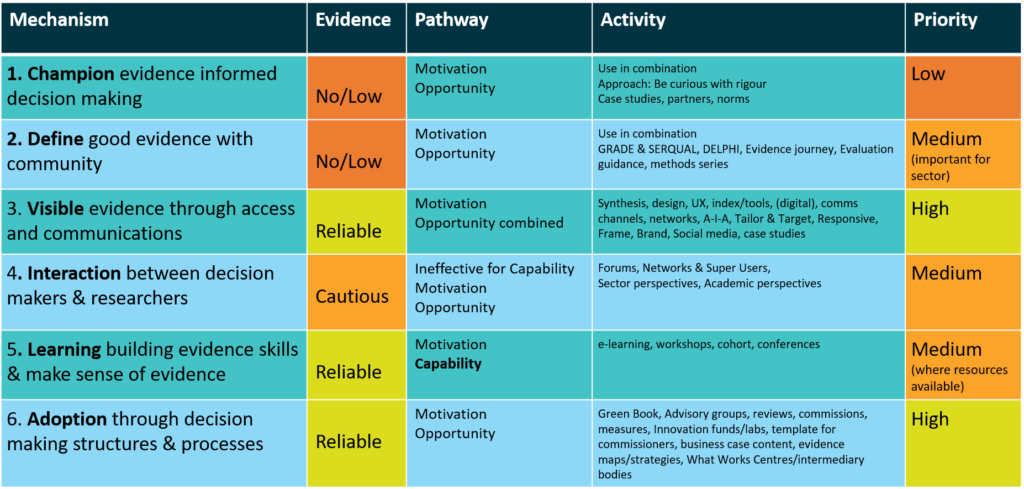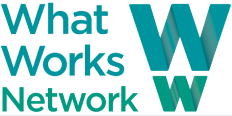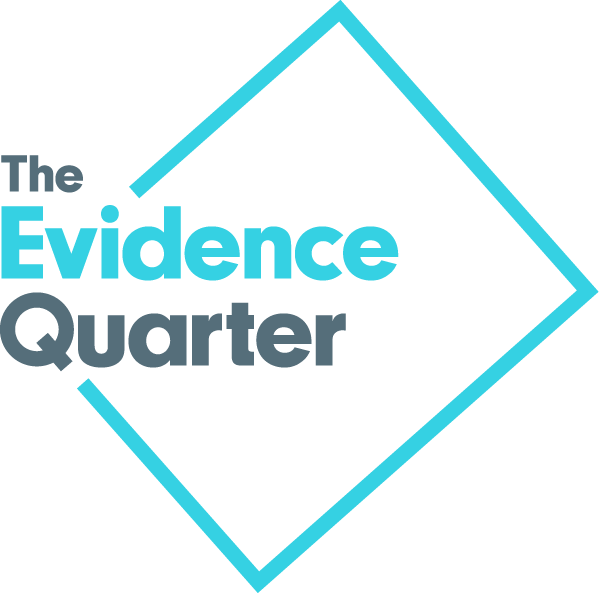Knowledge use & implementation
Knowledge use and implementation – why is it important?
What is the use of research evidence if it is then not used?
Whilst knowing ‘What Works’ is important, it is only part of the journey. It is important to know ‘How it works’ and most importantly ‘how to use and implement what we know works’.
We are building a learning system for wellbeing.
- See our Director Nancy Hey’s Presentation at the OECD Putting Wellbeing Metrics into Policy Action 3-4 October 2019
We are aiming for there to be effective, do-able, affordable wellbeing improving projects, programmes and approaches. These can be done by everyone, or offer learning for those trying them.
This means that people who can and need to use evidence
- know about it, and can find it
- find it useful, and can use it
- can contribute to what is known.
Decisions are made all the time. They will be made with or without evidence. Better decisions can be made if they are informed by good evidence. Evidence helps us learn, and can take a wide range of forms, some are more useful than others.
How do we improve how evidence informs decision-making in governments, businesses, communities and for individual people?
Successful knowledge brokers need to be trusted, robust, relevant and communicate well. This is based on research by Dr Lenihan “Institutionalising evidence-based policy: international insights into knowledge brokerage.” and is embodied in our governance, processes and approach: independent, evidence-based, collaborative, practical, iterative and open
Using the Science of knowledge mobilisation at the Centre
Setting up the Centre we did four things to ensure that what we did is evidence informed, relevant and useful:
- Evidence review of What Works for Research Use
- Public dialogues
- Stakeholder engagement
Delphi approach to culture & sport programme led by Brunel University London - Methods Guide for our reviews
People
-
Nancy Hey
What works for research use
In 2016 we partnered with Wellcome Trust, the Alliance for Useful Evidence, and the EPPI-Centre at UCL to understand how research evidence can best be used in decision making and published Science of Using Science.
This review:
- identified six mechanisms that are used to help knowledge use
- rated the quality of the evidence supporting intervention under each mechanisms and combination of mechanisms
- identified behavioural insights useful to understanding the role of each mechanism using the Capability, Motivation and Opportunity model. Other models of behavioural insights are also applied such as EAST in the communications mechanism.
The Centre has used this as the basis of its Theory of Change and through the evaluations of our projects and the Centre aim to add to the knowledge of knowledge use.
The framework: six categories of evidence-use mechanisms
Briefly, six underlying mechanisms of enabling research use in decision-making were drawn from the literature, and used to group the interventions studied. These are summarised below:
- Awareness – Building awareness and positive attitudes towards evidence use
- Agree – Building mutual understanding and agreement on policy-relevant questions and the kind of evidence needed to answer them
- Access and communication – Providing communication of, and access to, evidence
- Interact – Facilitating interactions between decision-makers and researchers
- Skills – Supporting decision-makers to develop skills accessing and making sense of evidence
- Structure and process – Influencing decision-making structures and processes

The Evidence Quarter – joining up the UK’s What Works Centres
We are part of the Evidence Quarter.
Each evidence organisation exists for a reason – to tackle a particular problem, or to help a particular group – but we face common challenges; around methodology, building movements, and achieving an impact with the research that we do.
The EQ aims to bring together centres to share physical space, increase collaboration, and tackle joint challenges together.
Existing What Works Network collaborations
- What works Summits in Wales, Scotland and Northern Ireland
- Wellbeing Evidence across the life course
- How evidence is used in local authorities
- Disadvantaged Places
- Trials with Policing and Education
- Trial with Children’s Social Care



